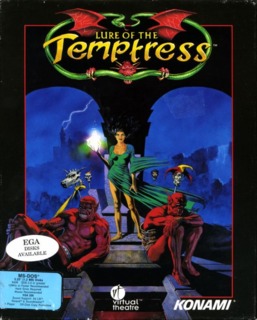INTRO:
Being perhaps the oldest game genre around, the adventure game genre had quite a few notable milestones which increased the sophistication of the genre. SCUMM, designed by Ron Gilbert and his contemporaries during their time at the now-defunct LucasArts, was one such milestone.
Eager to join the club, Revolution Software developed the Virtual Theatre engine, which was intended to allow NPCs to follow routines across several different scenes.
Although this engine would go on to become known for its use in notable adventure games like the Broken Sword series, its reputation did not go much further beyond its association with those games. This is because its main function was known for causing trouble as much as it was known for making NPCs which are more technically sophisticated than just one more part of a scene.
Unfortunately, the very first game to use Virtual Theatre happens to show the worst of Virtual Theatre’s drawbacks.

PREMISE:
For a game with fantasy settings, Lure of the Temptress is not about some ancient evil coming back to wreak havoc and there are certainly no princesses to rescue.
A powerful sorceress by the name of Selena is the titular ‘temptress’. Throughout the game, the player will discover how she rose to power, though this element of the story is ultimately a take on the trope of magicians discovering magic which is not meant for mortal use.
Of course, there is also the convenient accusation of the game having the trope of the “evil witch” by way of the antagonist’s gender. This accusation is made all the harder to dismiss because Selena will have next to active role in the story, despite her prominence in the title and box arts for the game. There is a wasted opportunity here to make a memorable villain(ess).
Anyway, true to one of the most enduring tropes of the adventure game genre, the hero is practically a nobody. He is no shining knight and initially has no motivation to get tangled up in the struggle against Selena, though he changes his mind from the start of the game. He has a name (Diermot), but it will rarely be uttered by other people (even after he has told them his name).
Anyway, after getting caught up in said struggle, seeing his newfound friends die and getting captured by Selena’s forces, Diermot decided that he should go on a quest of vengeance.
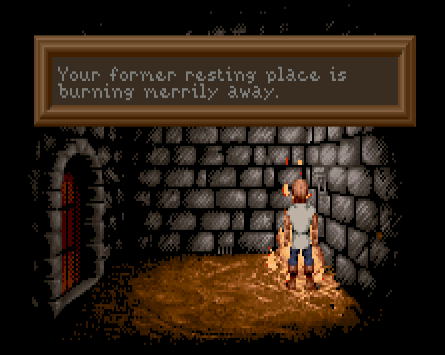
S.C.U.M.M.:
If the player checks the install directory of the game, or even check what programs the game is using when it runs, he/she would notice that the game uses SCUMM.
Veterans of the adventure game genre may remember that this was the system which was used to govern and enact the actions of the player character. However, instead of the actions being shown in an ugly user interface at the bottom of the screen, the game tucks them away behind the contextual menus which can be brought up with the right-mouse button.
(Coincidentally, this was done in Gilbert’s games after The Day of the Tentacle.)
SCUMM has also been implemented as a form of control over follower NPCs in what would have been an elegant integration with Revolution Software’s Virtual Theatre. The player can have Diermot telling these NPCs what to do, which is essential to the completion of some puzzles in the game.
Unfortunately, problems which are not due to SCUMM, or even anything inherently Virtual Theatre, soured the appeal of this game design. These problems arose from bad design decisions on the part of the developers, and will be elaborated later.
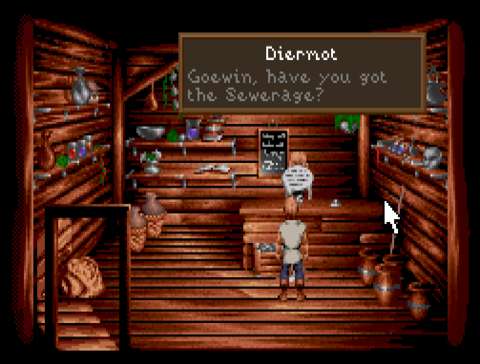
VIRTUAL THEATRE:
Lure of the Temptress is the first of Revolution Software’s games to use Virtual Theatre. On paper, it allows NPCs to move amongst multiple scenes, much like the player character can, as well as act out different behaviour scripting for each place.
This can be seen through the behaviour of many NPCs in the game, if they are not already sitting down, stuck behind a counter or standing guard over something. These NPCs also tend to strike up conversations with other NPCs, such as the two barkeepers in the town of Turnvale.
Unfortunately, in practice, the roaming behaviour of the NPCs is more frustrating than it is entertaining, mainly due to very poor pathfinding, which is turn due to infuriatingly finicky hit-boxes for the characters. This will be elaborated shortly.
HUGE HIT-BOXES FOR CHARACTERS:
The most common problem in the game is characters bumping into each other and failing to get around each other in order to continue their roaming scripts. Such bad path-finding is mainly due to the large hit-boxes which are used for characters who are moving around, including for the player character. This causes a couple of problems, which are as follows.
DIFFICULT TO APPROACH CHARACTERS FOR CONVERSATIONS:
The huge hit-boxes impede attempts by the player character to approach other characters in order to talk to them. This is especially observable when the player character is approaching others along a horizontal direction (relative to the player’s viewpoint).
Fortunately, there appears to be a built-in work-around for approaching characters for conversations. This work-around disables the hit-boxes for characters in the vertical direction (relative to the player’s viewpoint).
Yet, this means that the player character can only communicate with characters by walking up to them along the vertical axis of direction (relative to the player’s viewpoint); this can seem awkward.
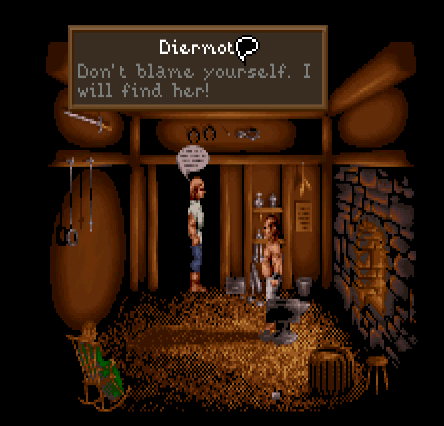
Incidentally, Revolution Software had addressed this issue in its later games, mainly by waiving hit-boxes and forcing characters into specific spots for the purposes of conversations (examples of this can be observed in Beneath a Steel Sky).
Yet, it has never re-visited Lure of the Temptress to work in this solution.
CHARACTERS GETTING INTO EACH OTHER’S WAY:
The huge hit-boxes also cause characters to bump into each other all too often.
At first, this may seem believable, even appealing. Characters who bump into each other either make polite utterances equivalent to “excuse me” or make rude remarks at each other. For example, almost every bumping encounter between the Skorl and the humans results in angry remarks being tossed at each other in passing.
Unfortunately, the bumping becomes a problem when Diermot has entered the town of Turnvale. There are a lot of characters who happen to move about, and they will be bumping into each other a lot and getting into each other’s way.
They also happen to block the player character too. It can be difficult not to get infuriated if this happens one too many times. This becomes even upsetting when the player is trying to have the player character follow another character and the other people just get in the way.
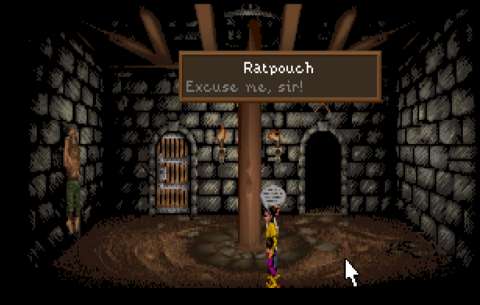
Again, Revolution Software had addressed this issue in its later games, apparently by reducing the hit-boxes of characters and disabling the hit-boxes if someone gets stuck behind another character.
Yet, it had not re-visited Lure of the Temptress to work in these solutions.
RESETTING ROAMING BEHAVIORS:
If any NPC (other than follower NPCs) is blocked by another character for too long (which is several seconds), the NPC has his/her/its roaming behaviour reset, though not necessarily to the default phase. The NPC attempts to go the closest locale which it has behaviour scripts for.
This might be a problem if the player has to shadow one of the NPCs, if only to figure out his/her/its full list of behaviours; there is at least one puzzle in the game which necessitates this. The NPC can be blocked by other NPCs, which then causes this NPC’s behaviour to reset.
There is a work-around for this, but it requires the player to already know the solution to the puzzle (and thus know where to wait for the NPC).
(By the way, the solution appears to come with the package for the game, if one is playing the re-release versions of the game.)
OFFSCREEN ROAMING & WAITING FOR CHARACTERS:
Fortunately, all that bumping and resetting does not occur for NPCs if the player character happens to be in other scenes which they are not in.
However, to be able to use this knowledge at all to track down an NPC, the player must already know the behaviour of the NPC. Even then, once the player does know this, he/she still has to have the player character wait at one of the places which the NPC stops by.
Waiting is not fun.
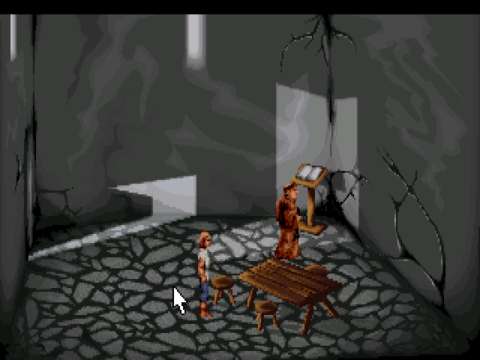
The off-screen roaming of NPCs is estimated in real-time. Sometimes, the player character or some other NPC may approach an exit to a scene, only to be repulsed by another character who has yet to enter the scene. This is because the game forces characters within the scene to make way for incoming characters.
This would not have been a problem if that incoming character actually comes in. Yet, the game also sets this other character back for a few seconds. This incoming character may then attempt to go through that exit again, and block the outgoing character again if this character re-attempts to exit.
A player who does not know this might be thinking that some glitch has occurred; the player may attempt to have Diermot walk through an exit, only to be repulsed several times by some other character whom the player cannot see.
SCRIPT TERMINATION:
It would appear that Revolution Software is aware of the pathfinding issues in the game to a certain degree. This can be seen when a follower NPC which the player has given instructions to is blocked from performing his/her instructions; a thought bubble with a question mark appears over their heads. They then revert to their original behaviour scripts.
Although this does prevent follower NPCs from being locked up due to bad pathfinding, it does not lessen the frustration of having to deal with the bad pathfinding in the first place.
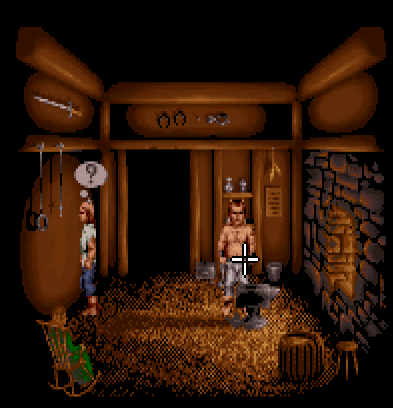
OUTDATED MANUAL:
The manual for the game appears to be a straight recycling of the manual for the original version of the game. This means that the manual refers to the original platforms when it informs the player of functions such as how to make save-games.
There has not been any effort to rewrite the manual to fit the present-day computer, much less any instructions on how to make better use of the MS-DOS emulator for the game.
At the very least, the manual still contains information on just about anything related to gameplay, including even some spoilers for the couple of combat segments in the game.
MOVING ON TO OTHER THINGS:
With all of the worst issues in the game out of the way, the better parts of the game are described next. However, the word ‘better’ is used in a manner relative to the less-than-good game designs which have been mentioned earlier.
When compared to its contemporaries, Lure of the Temptress would have been hardly memorable; it is perhaps best known for being the first game which uses Virtual Theatre, but little else which is remotely positive. Furthermore, and more importantly, it just pales in comparison with Revolution Software’s later games.
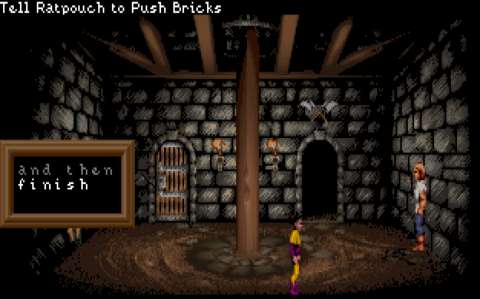
DIALOGUE:
Diermot will talk with other characters, but more often than not, he will only talk about what he should be doing next.
If one keeps his quest in mind, this is understandably acceptable. However, the contemporaries of Lure of the Temptress give opportunities to the player to have player characters ask NPCs to talk about their motivations and current situations.
To be fair to Lure of the Temptress, there are such opportunities, but they are very few. It is not clear what prerequisites have to be met in order to receive such opportunities too. (Generally, they occur late into a playthrough.)
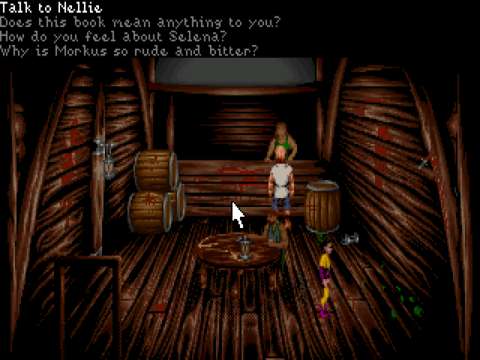
DIALOGUE GLITCHES:
Sometimes, the player may be unable to have Diermot talk to another character; the “Talk To” command just does not seem to do anything.
This tends to happen if the player saves the game or presses “Alt-Tab” to go out of the game and then come back again.
To work around this, the player has to reload a saved-game, or restart it if this fails to do anything.
EAVESDROPPING:
In what would become a staple of Revolution Software, Lure of the Temptress lets the player character look through windows to eavesdrop on conversations between NPCs. This is done in real-time, and is perhaps one of the more positive evidence of the sophistication of Virtual Theatre, at least at the time.
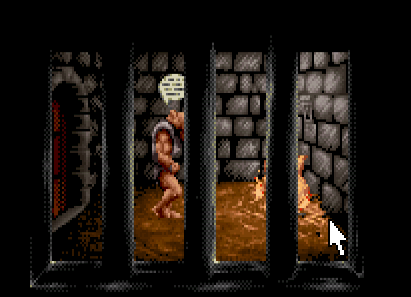
PROGRESSING IN THE GAME:
Most of the time, the player is clearly told what needs to be done. However, there are several points in the story where the solution to progression is not clear.
The player is given hints though, usually to the tune of “talk to everyone until you can actually do something”. Unfortunately, the player will come across the problems of bad pathfinding for NPCs when trying to do this.
On the other hand, most of the puzzle solutions are believably and logically sound when pondered in hindsight.
For example, it may initially seem odd that some ascetic monks know a thing or two about a dragon in Turnvale. However, giving this some more thought may help the player come to the realization that the monks’ order had been around for a long while and it retains the ancient lore of the town.
GAME OVERS:
During the time of this game, there was a segment in the adventure game genre which believes in game-overs as a way to punish the player. Lure of the Temptress is one of them.
There are a few scenarios in which Diermot can suffer clear cases of death. One of these is very much guaranteed if the player has not been paying attention to what should be done with regard to a certain large and ancient creature.
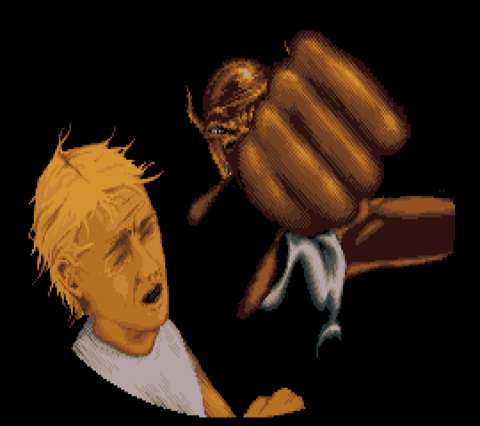
BATTLE SEQUENCES:
Speaking of Diermot’s combat capabilities, these are alluded to in the manual for the game. Indeed, there are a couple of fights in the game, in which the player must have Diermot parry attacks from an armed monster and time attacks to get through its guard.
The player makes these decisions through a system of context-sensitive mouse cursor icons. For example, hovering the mouse cursor anywhere far from Diermot’s sprite changes the cursor icon over to the icon for moving Diermot forwards or backwards. Hovering the cursor just in front of him instead turns the mouse cursor into the icons for attack inputs.
The rudimentary fighting system is mostly serviceable, though there may be minor complaints such as the hitpoint counters for Diermot and his opponent not being visible at all.
As for the opponents which Diermot would face, they are not too difficult to fight, once the player has noticed that the best time to pull off attacks is when they are pulling off attacks of their own. Attacking them at any other time simply has them parrying Diermot’s attacks and they may even get the upper hand.
At best, these fight scenes are palette-cleansers after having to point and click through so many things.
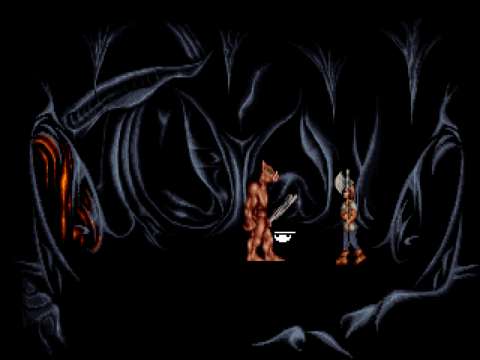
CHARACTER DESIGNS:
There are very few characters in Lure of the Temptress whom the player would remember well over the years.
As mentioned earlier, the titular character mainly resides in the background. Anything about her with regards to her significance in the story is only ever dealt with indirectly through the remarks of other characters about her.
Diermot himself downplays his own significance, especially in the ending.
Most of the other characters are designed along typical archetypes, such as Gwyn the town gossiper and Luthern the hard-drinking blacksmith.
At the very least, the writing has descriptions of these characters which effectively deliver imageries of them.
Perhaps the only character who is worth remembering is the oddly named jester, Ratpouch; he also happens to be the pseudo-author for the manual. He is slightly egotistical and sarcastic.
Unwittingly or not, he would be making remarks which hint at his own cowardly and rascally nature. There is also a running gag about his age, which can be seen when both Diermot and Ratpouch are in bars.
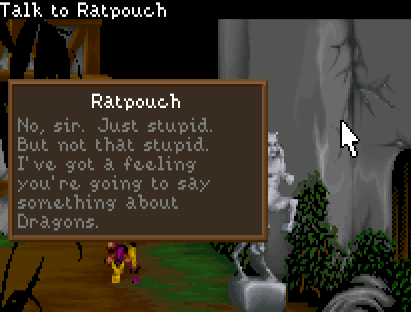
OTHER REMARKS ABOUT WRITING:
Lure of the Temptress would show that the writers at Revolution Software have the necessary capacity for the humour which is needed for entertaining writing.
There are jokes which are indirect references of old tropes about the adventure game genre (especially the text-based adventure games), such as searching things and finding nothing.
There are also jokes which make references at real-life, such as legal drinking ages. Speaking of drinking, there is more than a little writing about beer.
If there are flaws in the writing for the game, they are fairly minor, such as typos, e.g. “received” being miswritten as “recieved".
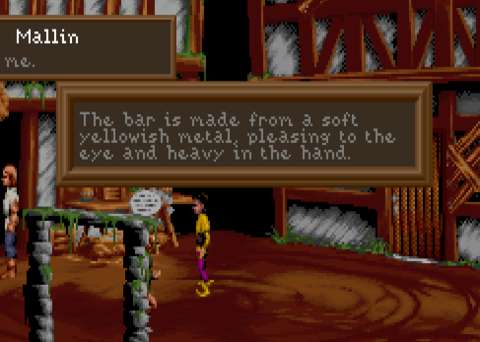
VISUAL DESIGNS:
Being a game which was made during the waning days of the era of MS-DOS, Lure of the Temptress makes use of what would then become known as pixel art.
For its time, Lure of the Temptress would have been considered as just decent, especially if it is to be compared with better funded contemporaries like LucasArts’ games.
Unfortunately, the game had not been spared of the trope of pixel-hunting. For example, small on-screen objects like knives, flowers and taps can be difficult to find with the mouse cursor.
The game also recycles a few scenes, namely some ivy-overgrown stone-cobbled alleyways. These are used to connect parts of Turnvale to each other; there is nothing to clearly indicate which of these alleyways lead to where.
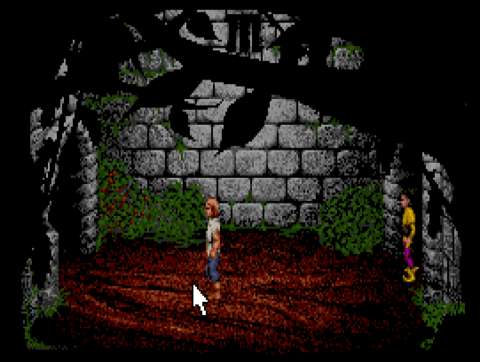
SOUND DESIGNS:
There are very few things to be heard in Lure of the Temptress. Most of the noises heard in the game are either 8-bit tunes or MIDI clips, none of which sound believably associable with the occurrences which they accompany. The game’s music is similarly lacklustre, and there is not any voice-acting to be heard.
CONCLUSION:
With its severe pathfinding problems, Lure of the Temptress makes a poor debut of Revolution Software’s proprietary Virtual Theatre. It also could not compensate with a memorably worthwhile story and it does not have a lot of entertaining characters.
Of course, to cut Revolution Software and Lure of the Temptress some slack, the game is offered for free on Good Old Games. Yet, with all of the issues mentioned earlier, investing time into this game may not be a wise decision, because the rest of the game may not be worth putting up with its frustrations.
This game is not guaranteed to be a timeless gem for everyone.
